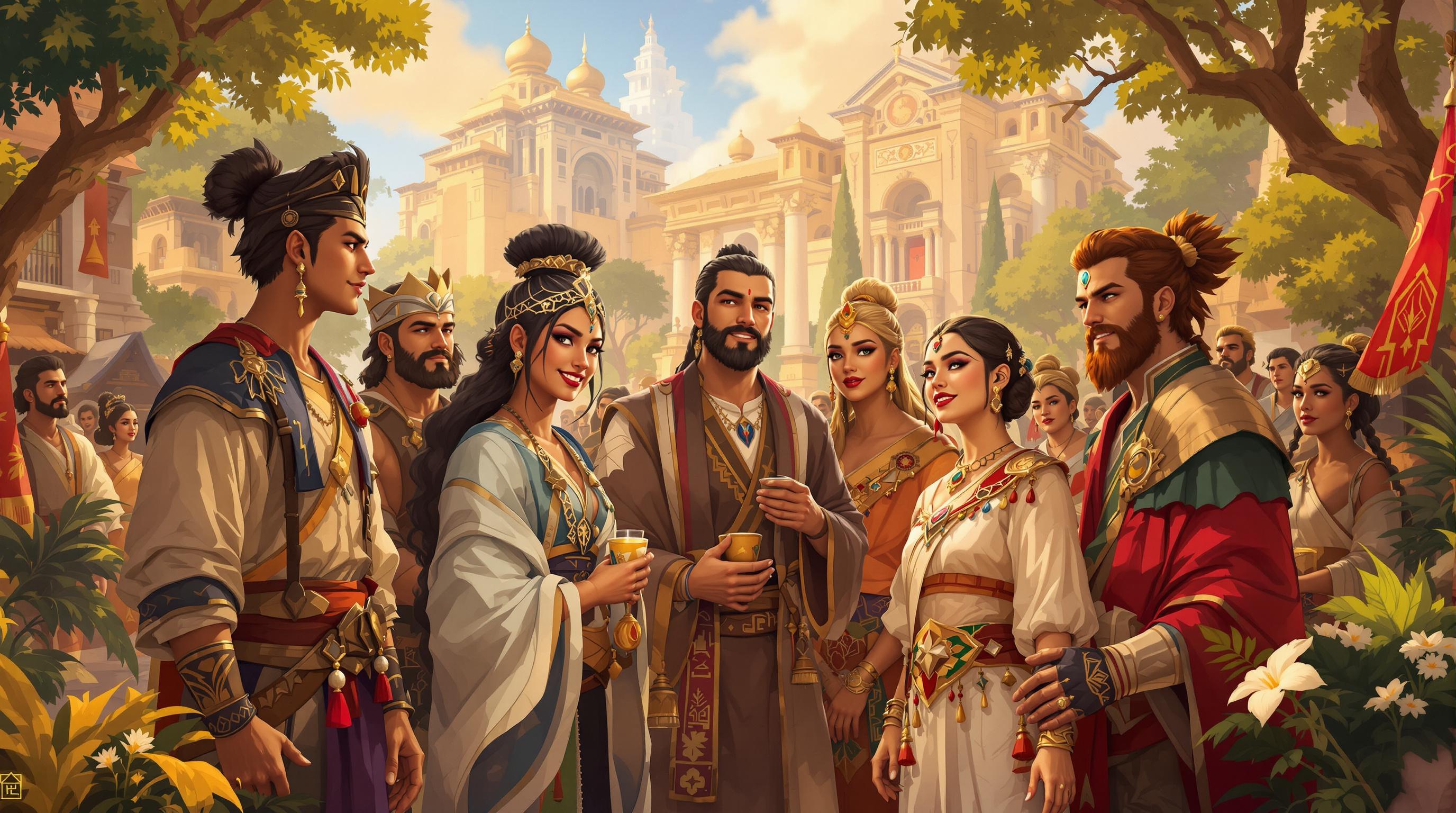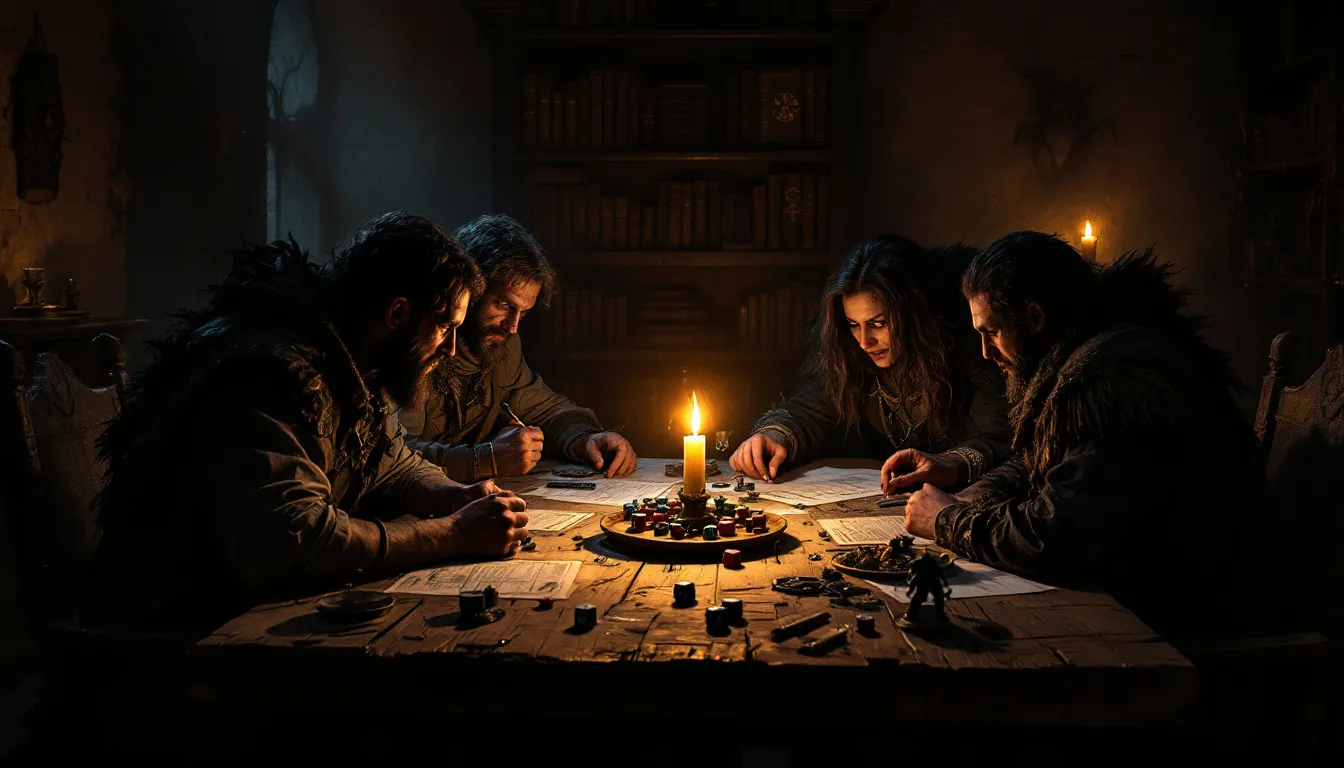In tabletop RPGs, dice often determine success or failure. But some systems go beyond this, turning dice rolls into tools for storytelling. These games use creative mechanics to shape narratives, share control between players and the GM, and make every roll meaningful. Here are 10 RPGs with dice mechanics that drive engaging stories:
- Blades in the Dark: Uses d6 pools with outcomes like full success, partial success with complications, or failure that sparks new twists.
- Ten Candles: A tragic game where a dwindling dice pool mirrors the loss of hope as real candles burn out.
- Star Wars RPG (Fantasy Flight Games): Custom dice with symbols create layered results that match the cinematic feel of the Star Wars universe.
- Genesys System: Expands the Star Wars dice mechanics into a universal system for any genre.
- Dungeon World: Powered by the Apocalypse, it uses 2d6 rolls to create success, partial success, or GM-driven complications.
- Fate Core: Employs Fate dice (dF) and narrative aspects to make every roll a storytelling moment.
- Cortex Prime: Features variable dice pools that reflect characters' traits and relationships.
- Savage Worlds: Introduces "exploding dice", where max rolls allow rerolls for dramatic outcomes.
- Shadowrun: Dice pools of d6s determine success, with glitches adding complications.
- Quest: A simple d20 system with a results table that ensures every roll advances the story.
These systems avoid binary outcomes, ensuring that both success and failure contribute to the narrative. Whether you're new to RPGs or a seasoned player, there's a game here for every storytelling style.
The Best Dice Systems for TTRPGs | Dev Log | Episode Two
1. Blades in the Dark

Blades in the Dark ramps up narrative tension with its dice pool system, which uses standard six-sided dice (d6). Players roll multiple dice depending on their character's abilities and the situation, but instead of adding the results, they focus on the highest single roll to determine what happens. This approach sets the stage for its unique outcome tiers, which keep the story engaging and unpredictable.
Different Dice Mechanics
The dice system operates on three key outcome tiers that shape the narrative. A roll of 6 means full success, where characters achieve their goals without a hitch. A roll of 4–5 signals partial success, where the character succeeds but faces some kind of complication. Rolls of 1–3 represent failure, but even failure sparks new storytelling opportunities, introducing fresh obstacles or uncovering critical details.
The dice pool isn’t static - it shifts based on circumstances. Skilled characters or favorable situations might allow for more dice, while tough conditions can reduce the pool. This dynamic system ensures that characters’ emotional and physical states directly influence their chances, adding layers of tension to every roll.
Narrative Integration
Blades in the Dark’s dice mechanics are designed to keep the story flowing, avoiding the usual pass/fail dichotomy. For instance, a roll of 4–5 might let a character sneak past a guard but at the cost of drawing suspicion, which could lead to a chase or a tricky negotiation. On the other hand, a roll of 1–3 might mean getting caught, opening the door to unexpected twists. These mechanics encourage improvisation, ensuring the story stays lively and full of surprises.
Player Accessibility
One of Blades in the Dark’s strengths is its simplicity. The familiar d6 mechanics and straightforward three-tier outcomes make it easy for players to pick up and enjoy, often within a few sessions. The rules are clear, and the dice system ensures that everyone around the table has a hand in shaping the story. For example, when a player rolls a partial success, they might describe how their character pulls off their goal, while the GM adds a complication. This collaborative approach keeps everyone engaged and invested in the unfolding drama.
2. Ten Candles
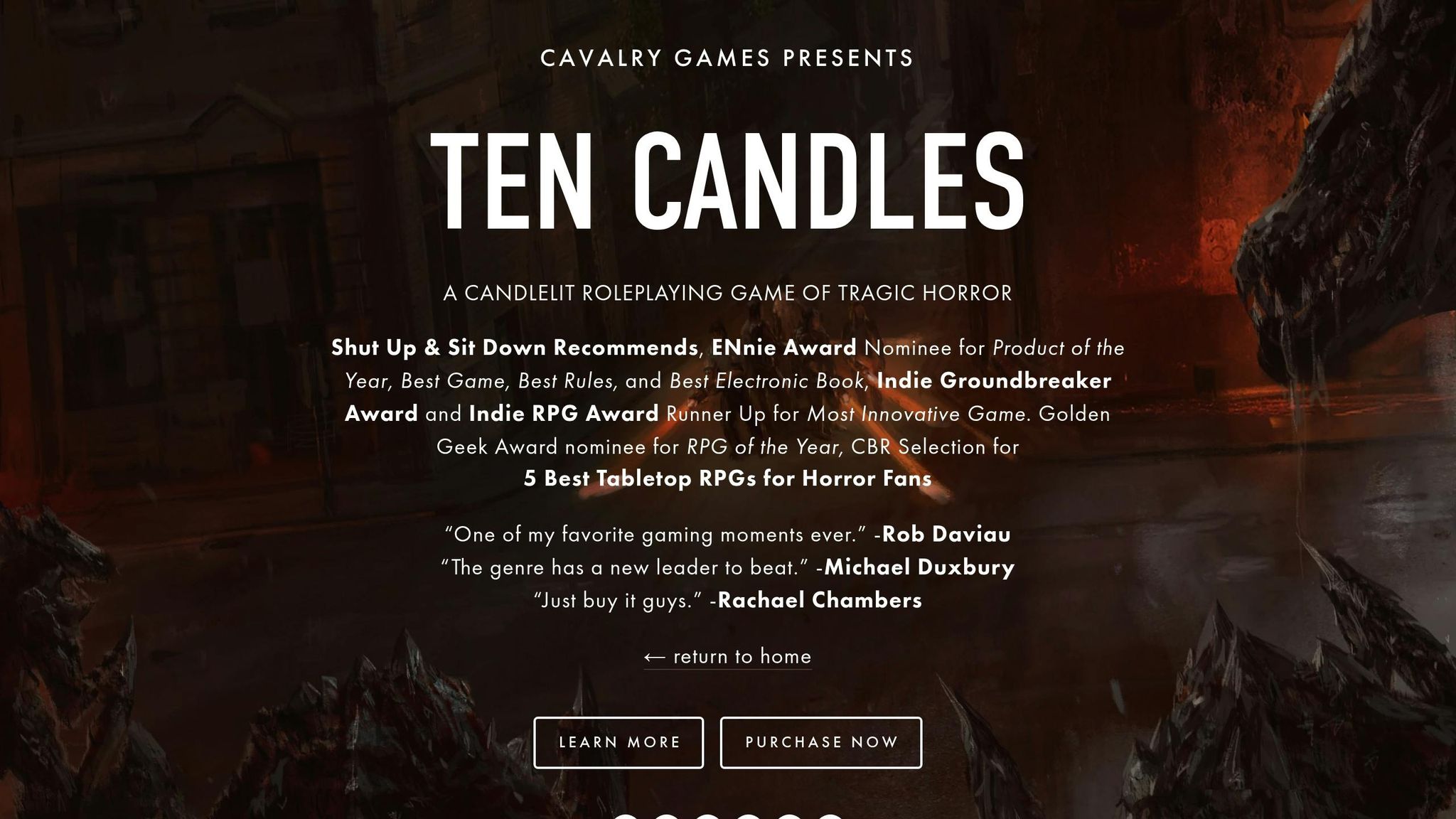
Ten Candles draws players into a haunting experience through its unique use of light - or rather, its gradual loss. The game uses ten physical candles to represent both fleeting hope and the passage of time. Alongside this, players rely on a pool of standard six-sided dice (d6) that determines their ability to face challenges.
How the Dice Work
The dice mechanics in Ten Candles are more than just a tool - they're a reflection of the game's grim tone. At the start, players share a collective dice pool that symbolizes their group's strength and resilience. Every time they face a challenge, they roll from this pool. But there’s a catch: failure doesn’t just impact the current moment - it permanently removes dice from the pool. With each unsuccessful roll, the dwindling dice mirror the growing sense of despair, forcing players to make tough choices about when to take risks.
Tying Mechanics to Story
What makes Ten Candles stand out is how its mechanics are tightly woven into its storytelling. Losing dice with every failure isn’t just a gameplay feature - it’s a narrative tool. As the dice pool shrinks, it reflects the characters’ gradual loss of hope, shifting the mood from cautious determination to sheer desperation. This seamless blend of gameplay and story creates an emotionally charged, immersive experience.
Easy to Pick Up and Play
One of the best things about Ten Candles is its accessibility. The dice pool mechanic is simple enough for anyone to grasp, and the game’s one-shot format - usually wrapping up in 3–4 hours - makes it perfect for a special game night or introducing newcomers to storytelling-focused RPGs. Whether you're a seasoned player or a first-timer, Ten Candles delivers a memorable and chilling adventure.
3. Star Wars Roleplaying Game (Fantasy Flight Games)

Fantasy Flight Games brought a fresh twist to storytelling RPGs with their Star Wars system, ditching traditional numbered dice in favor of custom dice with unique symbols. This change turns every roll into a moment of storytelling, perfectly mirroring the cinematic feel of the Star Wars universe. Let’s dive into how these custom dice shape the gameplay experience.
Unique Dice Mechanics
The game uses six types of custom dice: Ability, Proficiency, Difficulty, Challenge, Boost, and Setback. Instead of numbers, these dice are marked with symbols like Success, Failure, Advantage, Threat, Triumph, and Despair. What makes this system stand out is how these symbols combine to create layered results. For instance, a roll might show a Success paired with two Threats. In this case, a character might successfully hack a security terminal, but the Threats could mean an alarm is triggered or a trace is left behind - introducing new twists and challenges. This layered approach ensures every roll contributes to the unfolding narrative in unexpected ways.
Story-Driven Gameplay
The dice system seamlessly integrates storytelling into gameplay. Each roll becomes a collaborative moment for players and Game Masters (GMs) to interpret the symbols and weave them into the story. Even a failed roll doesn’t necessarily stop the action; it might reveal useful information or set up future opportunities. This approach ensures that every outcome - whether it’s a Success or Failure - pushes the story forward, keeping the game dynamic and engaging.
Learning Curve and Accessibility
Adapting to the custom dice system can be a bit challenging for players used to standard polyhedral dice. However, the symbols are designed to be intuitive, directly tying into story elements, which helps players pick up the system after a few sessions. The visual clarity of the dice and the collaborative nature of interpreting results reduce the need for complex calculations, making the game approachable for those who prefer a more narrative-driven experience. From the first roll, players feel immersed in the Star Wars universe, with every Triumph, Despair, or unexpected twist adding depth to the story and drawing everyone further into the adventure.
4. Genesys System
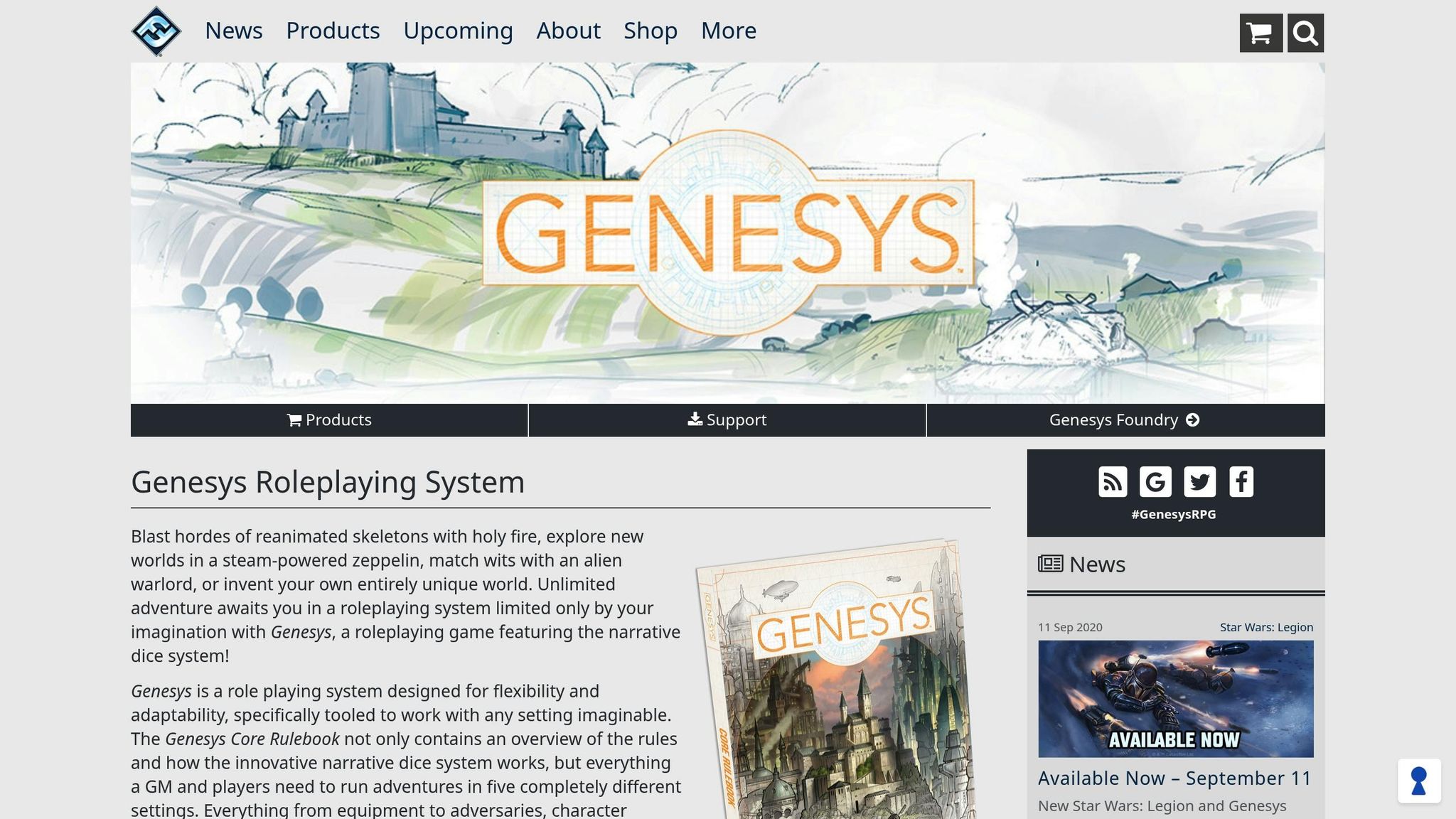
Fantasy Flight Games expanded the innovative dice mechanics from their Star Wars RPG into Genesys, a universal role-playing game system designed to work with any genre or setting. Released in 2017, Genesys takes the symbolic dice concept from its Star Wars roots and adapts it to a broader range of adventures, allowing for immersive storytelling across countless worlds and themes.
Different Dice Mechanics
Genesys uses six types of custom dice - Ability, Proficiency, Difficulty, Challenge, Boost, and Setback - each featuring unique symbols that create layered outcomes. The dice pool changes based on a character's skills and the situation at hand, tailoring challenges to fit the narrative. For example, in a fantasy setting, rolling a Success with an Advantage might mean you cast a spell successfully while uncovering a hidden magical artifact. In a cyberpunk world, the same roll could signify hacking into a corporate database while leaving a trail that might be useful later.
Narrative Integration
The system’s symbolic dice turn every roll into a storytelling moment, no matter the genre. For instance, rolling a Failure with two Advantages might mean a failed negotiation, but it also reveals a critical piece of leverage for future use. This approach ensures that every roll contributes to the story, encouraging players and GMs to collaborate in interpreting the outcomes. The flexibility of the dice system makes it easy to weave these results into the narrative, enhancing the storytelling experience.
Complexity
Genesys offers a balance between depth and ease of use, thanks to its modular rules. Game Masters can add features like magic or cybernetics to fit their campaign’s needs, offering a high degree of customization. Character creation involves selecting archetypes, careers, and talents that align with the chosen setting. While the system may feel a bit complex at first, most players find that after 3-4 sessions, they’re comfortable interpreting dice results and building effective characters.
Player Accessibility
New players often find Genesys approachable due to its focus on story-driven symbols rather than abstract numbers. The collaborative nature of interpreting dice rolls reduces the pressure to memorize detailed rules or perform complex calculations. While players need to invest in custom dice, shared sets or digital tools can make the transition smoother. With its emphasis on narrative outcomes over tactical combat, Genesys is particularly appealing to those who enjoy character-driven storytelling over mechanical optimization.
5. Dungeon World
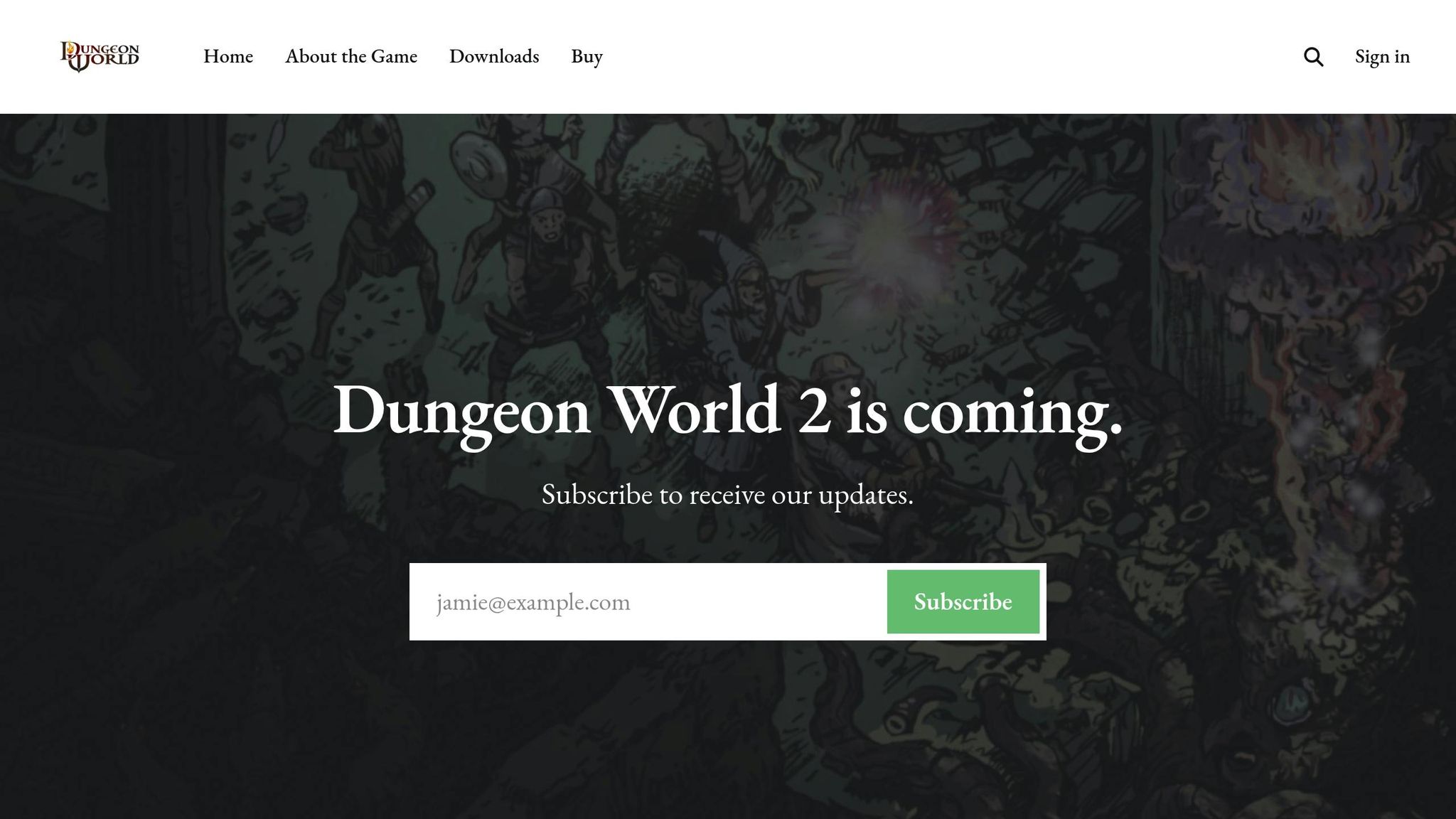
Dungeon World, crafted by Sage LaTorra and Adam Koebel, blends the classic feel of dungeon crawling with the dynamic "Powered by the Apocalypse" system. By pairing 2d6 rolls with narrative-focused moves, the game turns every roll into a moment that propels the story forward, creating a unique mix of traditional and storytelling gameplay.
A Unique Dice System
In Dungeon World, dice mechanics are refreshingly simple: players roll two six-sided dice (2d6) plus a modifier. The results fall into three clear outcomes: a 10 or higher means full success, 7–9 indicates partial success with complications, and 6 or lower triggers a GM move that introduces unexpected twists. Unlike many RPGs where failure can stall progress, Dungeon World ensures that every roll advances the story. For example, if a fighter uses the Hack and Slash move and rolls a 7–9, they might deal damage but face a tough choice - perhaps exposing themselves to a counterattack or having their weapon get lodged in an opponent's armor. These outcomes naturally lead to new story developments.
Story-Driven Mechanics
The game's move-based system transforms actions into story moments. Each character class comes with specific moves that activate under certain in-game circumstances, seamlessly blending rules with narrative. For instance, the Spout Lore move allows players to reveal details about the world by rolling dice, encouraging them to actively shape the setting rather than passively relying on the GM. This approach ensures that gameplay remains immersive and collaborative.
Balanced Complexity
Dungeon World strikes a sweet spot between depth and simplicity. Character creation is straightforward: players pick a playbook, assign stats, and choose their character's moves. For GMs, the game’s principle-based design eliminates the need to memorize lengthy rules or monster stats. Instead, GMs follow intuitive guidelines like "make a move that follows" or "ask questions and use the answers." This design not only reduces prep time but also keeps gameplay engaging and flexible.
Easy for New Players
Dungeon World is especially welcoming to newcomers. The moves are written in plain, easy-to-understand language, making it clear when and how to use them. The game emphasizes a conversation-first approach, where players describe their characters’ actions, and the appropriate move naturally follows. This method eliminates the need for scanning through complex rulebooks mid-game. The consistent 2d6 system and collaborative storytelling also help players - especially those new or shy - feel at ease. Most groups report picking up the system quickly, often within a single session. As with other narrative-driven RPGs, Dungeon World ensures that every roll becomes a spark for storytelling.
6. Fate Core

Fate Core takes a fresh approach to dice mechanics, using four specialized Fate dice (dF) to create a bell curve centered on zero. These dice - marked with plus signs, minus signs, or left blank - produce outcomes ranging from -4 to +4. This design ensures that every roll feels impactful and tied to the story, rather than being a purely random event. Like other systems we've looked at, Fate Core turns dice rolls into tools for storytelling.
Unique Dice Mechanics
What sets Fate Core apart is how it integrates dice results into the narrative. Players roll the four Fate dice, add their skill rating, and use the result to shape the story. The system also allows players to spend fate points to gain a +2 bonus or activate character aspects to influence outcomes. For example, a character with the aspect "Quick on My Feet" could use it during a chase to boost their Athletics roll, making the action feel more personal and story-driven.
Blending Mechanics with Storytelling
In Fate Core, dice rolls do more than determine success - they drive the story forward. Through aspects and stunts, characters and scenes gain narrative depth. Success with style, achieved by beating the difficulty by 3 or more, creates temporary advantages that players can use later. For instance, a successful roll to disable a security system might create the aspect "Security System Disabled" - a narrative tool that other players can invoke to shape future actions.
Balancing Simplicity and Depth
Fate Core keeps its core mechanics straightforward: roll the dice, add your skill, and compare the total to the target number. However, the interplay of aspects, stunts, and fate points adds layers of strategy. Players must decide when to use their limited fate points and how to frame their actions for maximum effect. Character progression focuses on evolving aspects and acquiring new stunts, ensuring that the mechanics continually support the unfolding story.
Collaborative Storytelling
Fate Core emphasizes collaboration, encouraging players to actively shape the world and scenes rather than relying solely on the GM. The create advantage action allows players to introduce new narrative elements during a scene, while the concede mechanic provides a way to exit conflicts gracefully, earning fate points as a reward. Even failed rolls contribute to the story, thanks to the system's "failing forward" philosophy, where setbacks open up new narrative opportunities. This collaborative, story-focused design makes Fate Core an engaging choice for players who love weaving their own tales.
sbb-itb-b8b00a5
7. Cortex Prime

Cortex Prime stands out by using dice of varying sizes to represent a character's unique traits. Instead of rolling the same type of dice every time, players might roll a small d4 for a weaker attribute alongside a powerful d12 for their strongest skill. This approach ensures that your dice pool directly reflects your character's strengths and weaknesses in a tangible way.
Different Dice Mechanics
Cortex Prime uses a step-die system, with dice ranging from d4 to d12, to showcase both a character's abilities and limitations. When making a roll, you gather dice from relevant traits - like a d8 for Agility, a d10 for Shooting, and a d6 for a Signature Weapon - and roll them together. From the results, you keep the two highest rolls and add them to determine your total. However, any dice showing a 1 introduce complications, which the GM can use to shake up the story.
Your dice pool isn’t just numbers - it’s dynamic, reflecting your character’s emotional state and relationships. For example, being angry might add a d6 to your roll, or your trust in another character could bring in additional dice. This means your dice pool evolves to mirror your character’s current situation, blending mechanics with storytelling in a seamless way.
Narrative Integration
Cortex Prime thrives on merging mechanics with storytelling. Failures and successes aren’t just numbers - they’re opportunities to shape the narrative. A key feature of the system is Plot Points, a type of narrative currency earned when your dice show 1s. These setbacks fuel the story, letting players spend Plot Points to add extra dice, activate special abilities, or even introduce new story elements that work to their advantage.
The system also uses Assets and Complications as temporary dice to reflect changing circumstances. For instance, gaining the upper hand in a fight might grant you a d8 "High Ground" asset for the rest of the scene, while a failed stealth attempt could land you with a d6 "Guards Are Alert" complication. These mechanics ensure that your actions have lasting consequences, creating a ripple effect where early choices shape the rest of the scene.
Complexity
Cortex Prime’s mechanics mirror its narrative depth, offering multiple layers of complexity. A character might juggle attributes, skills, distinctions, relationships, and signature assets, each represented by different dice. This variety adds strategic depth but also requires players to manage multiple elements.
The system’s modular design allows for flexibility, letting each game emphasize different aspects. Some campaigns might focus on emotional dynamics and relationships, while others lean into equipment or supernatural abilities. While this adaptability makes Cortex Prime versatile, it can also introduce complexity as players navigate which modules are in play for their specific game.
Player Accessibility
Even with its layers of complexity, Cortex Prime remains accessible to newcomers. The concept of "bigger dice are better" is intuitive, making it easy for players to grasp their character's strengths. The visual process of building dice pools also helps players quickly understand their character's capabilities. For example, seeing a d4 for Strength next to a d10 for Intelligence reinforces the character’s unique profile.
The system’s flexibility also offers multiple ways to succeed. A character who struggles with direct combat might still shine by leveraging their emotional state, relationships, or specialized knowledge. This ensures that every player has a meaningful role, regardless of their character's weaknesses or the challenges they face.
8. Savage Worlds

Savage Worlds introduces an "exploding dice" mechanic, where rolling the highest number on a die allows you to roll again and add the results together. This simple yet thrilling feature means even the smallest dice can lead to extraordinary outcomes. The system uses a variety of dice - d4, d6, d8, d10, and d12 - to represent different skill levels, but every die has the potential to "explode", creating moments of unexpected success.
Different Dice Mechanics
At its core, Savage Worlds revolves around rolling your skill die against a Target Number of 4. If your die hits its maximum value, you roll again and add the results, potentially reaching impressive totals. For example, even a humble d4 can rack up significant numbers with enough explosions.
In addition to the skill die, most characters (except extras) also roll a Wild Die - a d6 - alongside their skill die. You take the higher of the two rolls, and yes, the Wild Die can explode too. Degrees of success, or raises, are determined by how much you exceed the target number: every 4 points above the Target Number grants an additional raise, which can lead to bigger and more dramatic results.
Damage rolls operate a bit differently, using dice specific to the weapon. For example, a knife might deal 2d4 damage, while a greatsword might roll 2d6+2. Thanks to the exploding dice mechanic, even weaker weapons can occasionally deliver devastating hits, keeping combat unpredictable and packed with surprises.
Narrative Integration
Savage Worlds ties its mechanics closely to storytelling through the use of Bennies - tokens that reward bold actions and creative roleplay. Players earn Bennies for clever ideas, strong character moments, or enduring tough situations. These tokens can be spent to reroll dice, add an extra d6 to a roll, or soak damage, turning setbacks into opportunities for epic comebacks.
The exploding dice system naturally lends itself to cinematic moments. Imagine a character with a d6 Shooting skill landing an incredible shot after their die explodes three times in a row. What could have been a standard attack becomes a pivotal, action-packed scene.
The game also introduces Dramatic Tasks, which require players to achieve multiple successes over several rounds to complete complex objectives like disarming a bomb or performing a ritual. Each round's outcome contributes to the story, with failures adding twists and complications rather than halting the action entirely.
Complexity
Despite its flair for drama, Savage Worlds keeps things straightforward. Most actions follow the same basic formula: roll your skill die and Wild Die, and aim to beat a Target Number of 4. The exploding dice mechanic adds excitement without bogging players down with extra rules.
Combat is fast and efficient, using a simple initiative system (cards are dealt to determine turn order) and an easy-to-follow damage process. Instead of tracking hit points, characters use Shaken and Wounded conditions, making it quick to assess their status during intense moments. The system’s versatility allows it to handle a wide range of genres - from medieval fantasy to sci-fi epics - while maintaining the same core mechanics. Setting-specific rules add flavor without overwhelming players or Game Masters.
For those who want more, optional rules like Dramatic Interludes or Social Conflicts can be added seamlessly, letting groups tailor the game to their preferences while keeping the fast-paced, action-oriented feel intact.
Player Accessibility
Savage Worlds is beginner-friendly, thanks to its consistent mechanics and intuitive dice progression. The idea that "higher dice are better" is easy to grasp, and the exploding dice mechanic hooks players from the start with its potential for thrilling outcomes. There’s no need to memorize complex charts or formulas - most situations are resolved with a straightforward skill roll.
The inclusion of the Wild Die gives player characters an edge, making them feel heroic compared to standard extras. Meanwhile, Bennies act as a safety net, ensuring players have tools to recover from bad rolls or critical moments. This combination keeps new players engaged and confident, even without extensive experience.
Character creation is equally approachable, using a clear point-buy system that allows players to craft the hero they envision. The system’s adaptability means players can jump into entirely different settings - whether it’s a cowboy adventure, a superhero saga, or a space opera - without needing to relearn the rules. This flexibility keeps the learning curve low while offering endless opportunities for adventure.
9. Shadowrun

Shadowrun introduces a dice pool system that perfectly complements its cyberpunk fantasy setting. Instead of relying on a single die with modifiers, players roll a collection of six-sided dice based on their character's attributes and skills. Success is determined by how many dice roll high enough, creating a dynamic and high-stakes experience that mirrors the tension-filled world of corporate hackers and street mages.
How the Dice Work
The core mechanic involves combining dice from relevant attributes and skills. For instance, if a task calls for agility and stealth, you pool dice from both, increasing your chances of success. Rolls of 5 or 6 count as successes, and the number of successes - or "hits" - needed depends on the difficulty of the task.
Shadowrun also introduces the Edge mechanic, which adds a dramatic twist. Edge points can be spent to add extra dice, reroll failures, or even "push the limits" of a roll, representing those moments when determination or sheer luck makes all the difference.
Then there are Glitches. If more than half your dice roll as 1s, a Glitch occurs, throwing a wrench into your plans. If you don’t roll any successes alongside a Glitch, it escalates to a Critical Glitch, leading to major complications.
For opposed tests, the system pits one character's dice pool against another's. The side with more hits wins, whether it’s a street samurai in a knife fight or a decker trying to outsmart a corporate firewall.
Tying Mechanics to the Story
Shadowrun's dice pool system does more than determine success - it reflects a character's expertise. A specialist rolling 15 dice for a task clearly stands out from someone rolling just 6. However, the randomness of dice ensures that even experts can stumble, which ties perfectly into the game's themes of betrayal and survival in a gritty, cyberpunk world.
Edge points also create cinematic moments. Whether it’s a tense negotiation with a corporate exec or a desperate leap between skyscrapers, spending Edge feels like a character’s defining moment.
For complex challenges, tasks can be broken into multiple rolls, with successes accumulating toward a final goal. For example, hacking into a corporate mainframe might require hitting a target number over several rounds. Failures might trigger alarms or add complications, but they rarely bring progress to a standstill. This approach keeps the tension alive and allows the story to evolve naturally.
The Challenge of Complexity
While the basic dice mechanics are straightforward, Shadowrun’s depth comes from its wealth of options. The game offers an extensive list of skills, cyberware enhancements, spells, and hacking programs. Combat introduces layers like damage types, armor ratings, and special effects, which can be overwhelming for new players.
The Matrix rules for hacking operate as their own subsystem, complete with unique mechanics and challenges. Similarly, riggers who control drones and vehicles, or magic users managing spell drain, summoning, and astral projection, bring their own complexities. Even initiative is more intricate than in many games - characters with cybernetic upgrades often act multiple times per round, emphasizing the game’s focus on technological superiority.
For experienced players, this complexity is a feature, not a bug. It rewards creativity, strategic thinking, and specialization, making every character feel distinct and capable.
Easing Into the Game
Shadowrun’s layered systems can feel intimidating at first, but the core dice pool mechanic is easy to grasp and incredibly satisfying. Rolling a handful of dice and counting successes feels tactile and rewarding, especially during dramatic moments.
For beginners, pre-generated characters are a great way to dive in. Archetypes like the street samurai, decker, face, or mage highlight different aspects of the game and provide a solid foundation for learning how it all works.
Game Masters can also ease players into the system by starting with simpler challenges - like physical tasks or social encounters - and gradually introducing more complex elements like Matrix runs or magical threats. This step-by-step approach helps players adjust without feeling overwhelmed, while still showcasing the game’s unique blend of cyberpunk tech and urban fantasy.
Shadowrun’s dice pool system isn’t just a mechanic - it’s a storytelling tool that captures the essence of its world. From the thrill of rolling dice to the depth of its layered systems, it continues to push the boundaries of narrative-driven gameplay.
10. Quest

Quest keeps things simple with its d20 mechanic, which drives the story forward in a dynamic and engaging way. Using a single twenty-sided die and an outcome table, it transforms every roll into a clear narrative prompt. This approach shows that straightforward systems can still lead to deep and memorable storytelling.
How the Dice Work
At the heart of Quest's gameplay is a single roll of a twenty-sided die, paired with a results table that splits outcomes into three categories:
- Roll 14 or higher: Full success.
- Roll between 7 and 13: Partial success with complications.
- Roll 6 or lower: Failure, but the story still moves forward.
This structure breaks away from the typical pass-or-fail mechanics of many RPGs. Instead, every roll - whether good or bad - becomes a chance to expand the story. For example, a failed roll doesn’t mean the end of the road; it simply shifts the direction of the narrative, keeping the game moving and players engaged.
Storytelling That Flows
Quest’s mechanics are tightly woven into its storytelling. Each roll isn’t just about success or failure - it’s a chance to add depth to the narrative. The results table doesn’t just tell you what happens; it gives you story cues that inspire creativity. Imagine a player trying to persuade a guard to let them pass. A roll of 9 might mean the guard is partially convinced but asks for a bribe. This outcome creates a new twist in the story, sparking fresh challenges and opportunities for character development.
Easy for Everyone
Quest’s simple mechanics make it incredibly accessible, especially for new players. With just a single die and an easy-to-follow table, anyone can jump in and start building the story without feeling overwhelmed.
But simplicity doesn’t mean sacrificing depth. By streamlining the rules, Quest opens up space for players to focus on what really matters: character interactions, creative solutions to problems, and storytelling that feels natural and fun. For Game Masters, the straightforward system means less time spent preparing or refereeing rules, making it easier to run a great session - even without years of experience.
Game Comparison Table
Picking the right storytelling RPG can feel overwhelming, but this table simplifies the decision-making process. It highlights the mechanics, narrative depth, complexity, and ideal group sizes for each game, helping you match your group’s preferences and experience level.
| Game Name | Dice Mechanic Type | Narrative Integration | Complexity | Ideal Group Size |
|---|---|---|---|---|
| Blades in the Dark | Position & Effect with d6 pools | High – consequences drive story forward | Medium | 3-5 players |
| Ten Candles | Diminishing dice pool | Extreme – dice loss drives a tragic narrative | Low-Medium | 3-6 players |
| Star Wars RPG (FFG) | Custom narrative dice symbols | High – custom symbols drive the story | High | 3-5 players |
| Genesys System | Custom narrative dice symbols | High – adaptable to any setting | High | 3-6 players |
| Dungeon World | 2d6 + stat with three outcomes | High – moves trigger fictional events | Medium | 3-5 players |
| Fate Core | 4dF (Fudge dice) with aspects | Extreme – aspects shape every scene | Medium | 3-5 players |
| Cortex Prime | Variable dice pools | High – customizable narrative focus | Medium-High | 3-6 players |
| Savage Worlds | Exploding dice system | Medium – wild results create drama | Low-Medium | 4-6 players |
| Shadowrun | Large d6 pools with thresholds | Medium – glitches add complications | High | 4-6 players |
| Quest | Single d20 with outcome table | High – every roll advances story | Low | 3-5 players |
Complexity Ratings: Games like Quest and Ten Candles are easy to learn, often taking just 15 minutes to explain. On the other hand, systems like Shadowrun and Star Wars RPG (FFG) demand more time and effort due to their intricate mechanics.
Narrative Integration: In games like Fate Core, the dice and story are inseparable - every roll directly shapes the narrative. Meanwhile, games such as Savage Worlds focus more on resolving actions, with narrative elements as a secondary feature.
Ideal Group Sizes: Smaller groups thrive in narrative-heavy games like Blades in the Dark, where storytelling takes center stage. Conversely, systems with tactical elements, such as Savage Worlds, can accommodate larger groups without slowing gameplay.
Conclusion
Looking back at these ten RPGs, it's clear how inventive dice mechanics can elevate storytelling at the table. Whether it's the dwindling candles of Ten Candles that weave an inevitable tragedy or the thrilling unpredictability of exploding dice in Savage Worlds, each system uses dice to shape the story rather than disrupt it.
What ties these games together is their emphasis on storytelling over simple success or failure. These mechanics create natural twists in the narrative, turning setbacks into chances for character growth and plot development. For example, Star Wars RPG uses custom dice to introduce simultaneous advantages and threats, ensuring every roll pushes the story forward in unexpected ways.
The complexity of these systems varies, making it easy for groups to find one that suits their style. New players might gravitate toward the simplicity of Quest or Ten Candles, while seasoned players may enjoy the deeper challenges offered by games like Shadowrun or Genesys.
In these games, dice do more than decide outcomes - they build tension and propel the story. Traditional pass-fail mechanics only tell you if something works, but these systems go further, showing how it works and what happens next, turning randomness into narrative energy.
If you're looking to try something new, think about what fits your group's style. Story-focused groups might love the flexibility of Fate Core or Cortex Prime, while those who enjoy blending tactics with storytelling might find Dungeon World or Savage Worlds a perfect fit.
Dice in these systems are more than tools for success - they're engines for storytelling. Check out the TTRPG Games Directory for a closer look at each system and find the one that’s just right for your next adventure.
FAQs
How do unique dice systems make storytelling in RPGs more engaging?
Unique dice systems play a key role in bringing tabletop RPG narratives to life, seamlessly tying game mechanics to the story's mood and themes. Take Ten Candles, for example - its dwindling dice pools heighten the sense of urgency and tension as the game progresses. Meanwhile, the custom dice in systems like Genesys or Star Wars: Edge of the Empire add layers to the storytelling, offering nuanced and unpredictable outcomes with every roll. These mechanics do more than just determine success or failure; they make each roll feel significant, pushing the story in unexpected and engaging directions.
By weaving inventive dice mechanics into their design, RPGs create immersive experiences that captivate players, making the gameplay as distinctive and memorable as the tale being told.
Why is 'Ten Candles' a great choice for beginners in storytelling RPGs?
'Ten Candles' is a fantastic option for newcomers to tabletop role-playing games because it’s incredibly easy to dive into. With no preparation required and designed as a one-shot experience, you can jump right in without worrying about setup or long-term commitment.
The rules are straightforward and intuitive, letting players focus on building a shared story rather than getting stuck on complicated mechanics.
Set in a tragic horror setting, the game thrives on improvisation and collaborative storytelling. This approach not only sparks creativity but also fosters teamwork, making it an ideal gateway for anyone looking to explore storytelling RPGs.
How do custom dice in the Star Wars RPG enhance the cinematic storytelling experience?
Custom dice in the Star Wars RPG bring storytelling to life by going beyond basic success or failure. Instead of numbers, these dice feature unique symbols that represent narrative outcomes, sparking creativity and adding depth to the story. Whether it’s a moment of triumph, a sudden twist, or a surge of tension, these symbols help shape the drama in unexpected ways.
This approach transforms gameplay into a shared storytelling experience. Players and Game Masters collaborate to craft epic, cinematic moments that truly capture the spirit of the Star Wars universe.
